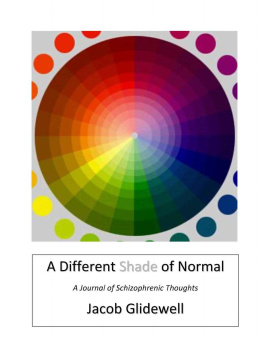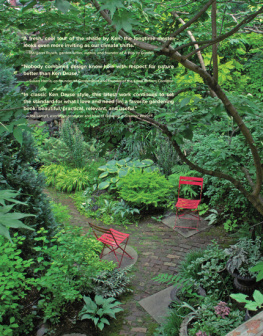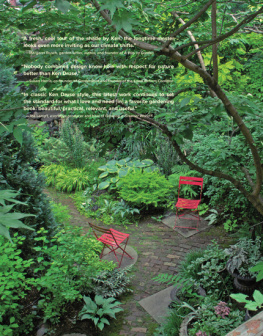
A stunning Rhododendron collection growing at the Royal Horticultural Society Garden Wisley in Surrey, England.
Glorious Shade
Dazzling Plants, Design Ideas, and Proven Techniques for Your Shady Garden
Jenny Rose Carey
Timber Press
Portland, Oregon
To my husband, Gus, and my daughters,
Meade, Janet, and Emily, all of whom
have shared in the development of
our shade garden.

Raindrops glisten on the young leaves of Cercis canadensis.
Contents

An English bluebell wood is the essence of springtime.
Preface
My journey to shade gardening came about through my early love of trees and natural areas. Growing up in a village in rural England, we took long walks beneath trees, through shady lanes, and along hedgerows. With my botanist father as a guide, wed stop at each plant and he would tell me its name. I learned from a young age that certain plants could only be found in the partial shade at the base of a hedge, while others only grew well in the full shade of woodlands.
I loved the cycles of the year and the dramatic changes that happened in shaded areas. In spring, we strolled through woods carpeted with scented English bluebells of an ethereal blue that no photograph could ever capture. In fall, we walked through crunchy, fallen leaves that emitted their characteristic bittersweet smell when crushed beneath our feet. Years later, I still love to walk through woods wherever I am, including around my Pennsylvania home. The woodlands here are carpeted with Virginia bluebells in spring and shaded by soaring oaks, spreading beech trees, and wonderful flowering dogwoods and redbuds. The natural layers of the wild places that I love to explore inspire my garden designs. I tuck plants into every garden cornertall trees, smaller understory trees and shrubs, and an herbaceous layer at ground level.
When I first moved to the United States, I had to adapt to the new climate, different soils, and a whole new set of plants. My garden, Northview, was then extremely overgrown; choked with vines and invasive plants. The first thing that I set out to do after arriving was to identify which plants would stay and which should be removed. After clearing out the unwanted vegetation, I reached out to gardening friends and neighbors for advice on making smart plant choices. They then generously offered me plant divisions and seeds that were suited to this region, helping me on my way.
The shaded areas of my garden look very different today than they did when I first moved inthey now offer a retreat. There are cool, refreshing places to sit away from the heat of the sun and paths that entice visitors to explore. The garden is plant-packed and personal and it suits my house, the area where I live, and the needs of my family.
My shade garden is a constant source of joy to me. I walk around my garden paths as often as I can to see what has happened since I last looked. Close observation is always coupled with anticipation: what flower buds have opened since yesterday? Have the fern fronds unfurled? The growing cycles of the year give me things to look forward to in every season: a profusion of spring blossoms followed by summer greenery, colored fall leaves, and then the subtle joys of winter.
I understand that gardening in shade is a long-term process. I have learned to wait and have patience while saplings grow, bulbs emerge from the soil, and shrubs become big enough to flower. I garden at an unhurried pace. I appreciate and enjoy the gradual transformations that occur year after year. I would never want my garden to be finishedgardens are all about growth and change, after all.
I have designed the garden to encourage a diversity of plants and animals because I am aware of the role it plays in the larger ecosystem that surrounds me. I have included as many native plants as possible and am committed to making the space a haven for pollinators, birds, and other wildlife. There are water features to provide fresh water and plants where food, shelter, and places to nest can be found.
No garden stays the same for long. I plan for the succession of shade in my garden by planting young trees of all shapes and sizes that will grow up and take the place of older, declining specimens. I have the benefit of gardening beneath majestic, shade-providing trees that were planted here over a century ago. I am just one in a long line of care- takers that have gardened and will continue to garden in this space. I encourage you to view the process the same way; planting new trees will provide you and future gardeners with all of the benefits of a shaded area.
As you develop your own shade garden, choose trees that you love, fill your space with plants that inspire you, and arrange them in ways that please you. Your garden will be an outdoor place that is as unique as you are, and will provide pleasure for you, your family, and your guests.
The ever-changing beauty of the shade garden is a celebration of life; a multifaceted ecosystem full of a diverse community of plants and animals. The lush greenness of the vegetation provides a cool, soothing place to relax, protected by the enclosure of the sheltering trees or walls. Rather than stress over your shady spaces, it is time to celebrate them and revel in the benefits that a glorious shade garden will bring to your life.

In the shade garden at Northview, Virginia bluebells mingle with other charming, pastel spring flowers.

Ulmus americana, American elm, is one of the most majestic canopy trees.

This beautiful space shaded by walls, hedges, and Magnolia trees at the Sissinghurst Castle Garden in Kent, England, brings back happy memories of my childhood.

Ever-changing shade patterns along an azalea walk at Jenkins Arboretum and Gardens in Devon, Pennsylvania.
Shades of Shade
Observing Shifting Patterns in Your Garden
Shade in a garden is not a tangible thing; it is a fragile, ephemeral, will-o-the-wispy shape-shifter, hard to define because it changes with the path of the sun. Because of its transient nature, it is difficult to describe and even harder to comprehend. Try explaining shadows to a young child. I remember watching one of my daughters, at age two, discovering her shadow. She saw it, bent down to touch it, but then it changed; she stood up, walked toward it, and carried on along the path trying to figure it out. In our own gardens, watching shadows is fun and fascinating. Learning about our shade patterns is an interesting process, but well worth the effort, because it makes us better gardeners.
Next page
























